Chapter 26: Japanese art after 1333
1/6
There's no tags or description
Looks like no tags are added yet.
Name | Mastery | Learn | Test | Matching | Spaced |
|---|
No study sessions yet.
7 Terms
Bunsei LANDSCAPE
Muromachi period, mid 15th century.
Hanging scroll with ink and light colors on paper,
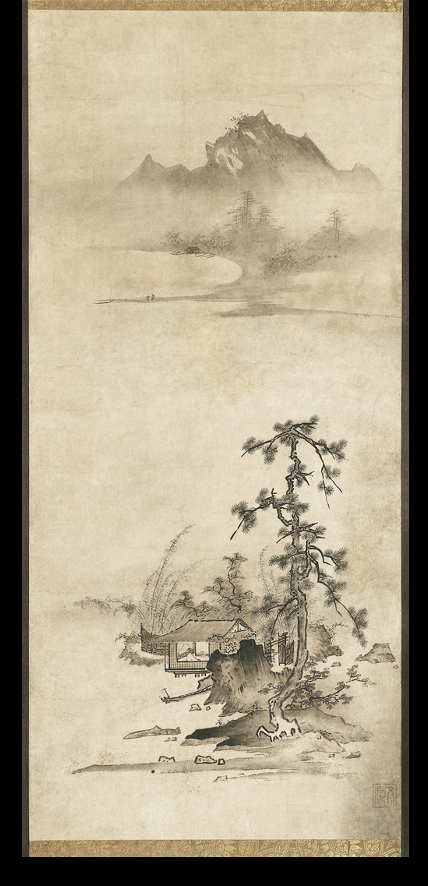
Zen ink painting
During the Muromachi period, creation of brightly colored narrative handscrolls in traditional Japanese style continued, but monochrome painting in black ink and its diluted grays-which had just been introduced to Japan from the continent at the end of the Kamakura period
Muromachi ink painting influenced by aesthetics of Zen. Chinese-style landscapes in ink also began to be produced. Traditionally, the monk-artist Shubun is regarded as Japan's first great master of ink landscape painting. no undisputed work of his survives. Two landscapes by Shubun's pupil Bunsei however, do survive.
Landscape painting is closely modeled on Korean ink landscape paintings which were copied from Ming-period chinese models.
Foreground with spit of rocky land with overlapping series of motifs; spiky pine trees, craggy rock, poet seated in hermitage, brushwood fence surrounding small garden of trees. and bamboo
middle ground is open space- emptiness, void
we are expected to “read” the unpainted expanse as water
beyond blank space is subtle tones of gray ink delineate a distant shore with fishing boats, hut, 2 ppl standing
2 parts of painting echo each other
Illustrates pure, lonely, and ultimately serene spirit of the Zen poetic landscape tradition
ROCK GARDEN, RYOANJI, KYOTO
Muromachi period, c. 1480.
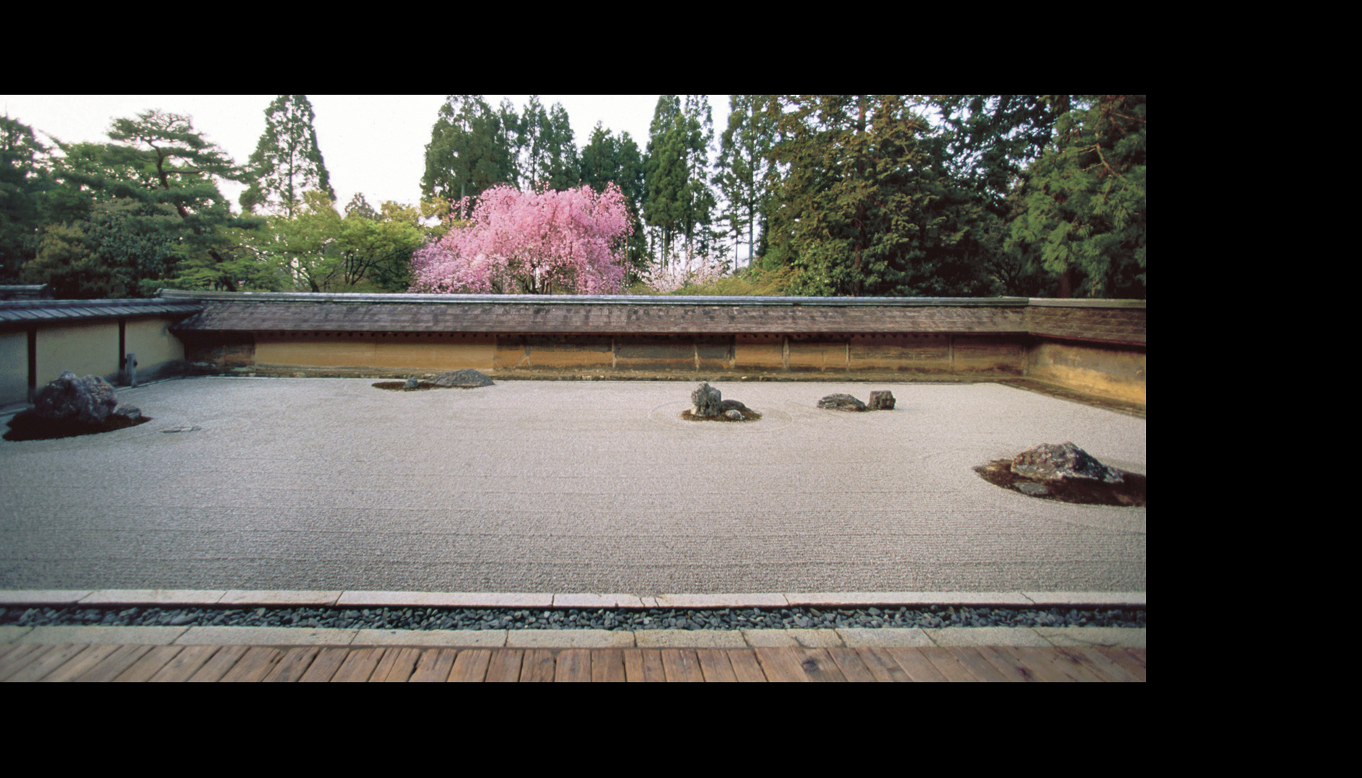
Zen monks led austere lives in quest for attainment of enlightenment. Did daily meditation, manual labor to provide for themselves and the temple’s properties
Zen temples constructed dry landscape courtyard gardens for the purpose of contemplative viewing.
Cleaning and maintaining the gardens was active meditation that help keep the monk’s monks grounded.
dry landscape know as ”dried up mountain and water” is in perfect harmony with zen buddhism.
Infront of abbot’s quarters , most renowned sen creation in Japan
rectangle raked gravel surrounds 15 stones of different sizes in islands of moss.
stones in asymetrical groups of 2, 3 and 5
low plaster covered walls establish the boundaries, beyond the wall is maple, pine, and cherry trees adding colour and texture. called “borrowed scenery” they are still apart of the design even though they are beyond the garden
Severity and emptiness
Dry gardens started in 15th and 16th cent in Japan. 16th cent chines landscape painting influenced garden composition so miniature clipped plants and beautiful stones were arranged to resemble famous paintings
dates from mid 17th cent which stone and garvel gardens had been intellectualized, abstract reflections of nature
Interpreted as representing islands in the sea or mountain peaks rising above the clouds or swimming tigres with her cubs or constellations of stars and planets all or nonre could be associated to monks seeking clarity of mind though contemplation
Chojiro TEA BOWL, CALLED YUGURE ("TWILIGHT")
Momoyama period, late 16th century. Raku ware
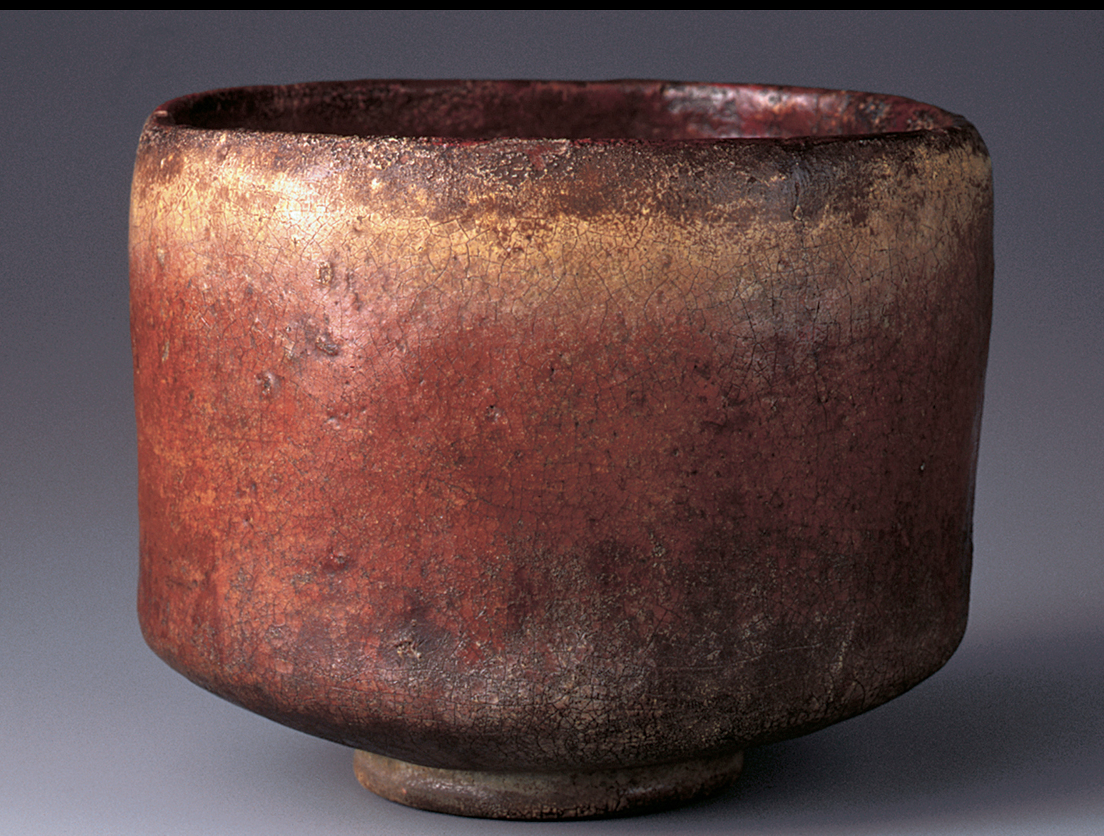
Sen no Rikyu TAIAN TEAROOM
Myokian Temple, Kyoto. Momoyama period, 1582.
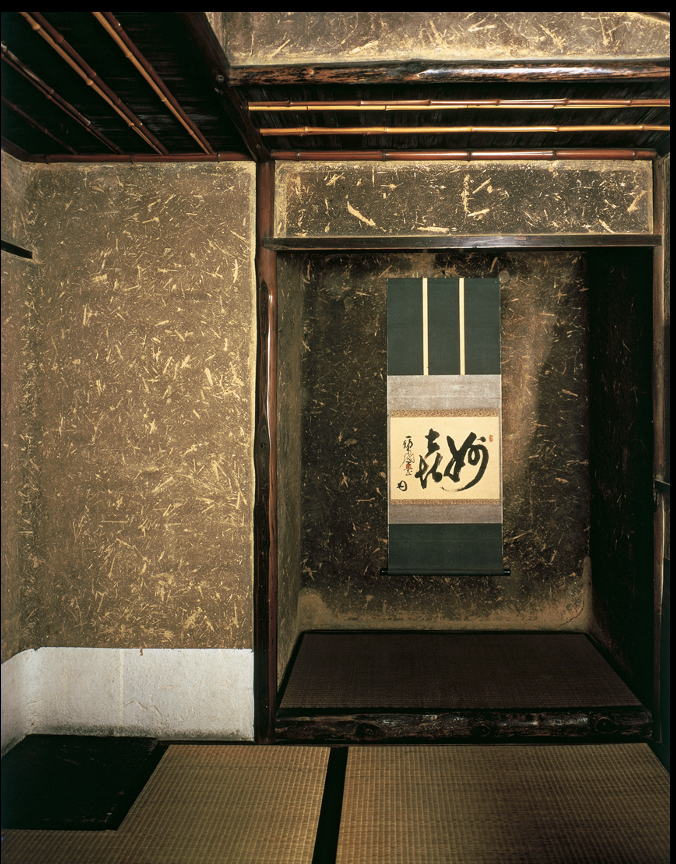
Tea room Sen no Rikyu
Sen no Rikyu was the most famous tea master in Japan, tea ceremony was an intimate gathering, few people from diff background(warrior, merchants, courtier) would enter small rustic room , drink prepared tea and discuss tea utensils or zen hanging scrolls
he largely established the aesthetic of modesty, refinement, rusticity promitting the tearoom to serve as a respite from the busy and violent world outside.
traditional tea room combine elegance and rusticity
made of natural material like bamboo and wood, mud walls, paper windows, floor covered in tatami.
has tiny door(guest must crawl to enter) and miniature alcove for displaying zen scrolls or flower arrangement
first glance looks symmetrical but deeper look shows disposition of tatami doesnt match spacing of tokonoma, an undercut of irregularity.
walls seem warm but with age but tatami keeps them fresh
quiet mood, light muted and diffused through 3 paper windows. Spatial clarity. Non essentials are eliminated theres nothing to distract the focu. Tea room important in japanese culture
Tea room bowl
all untensil associated with tea, especially the tea bowl came to be appreciate for its aesthetic quality, many work of art were created for use in chanoyu
old age japanese admired natural and asymmetrical found in tea ceramics
Korean style rice bowl made for peasent became the epitome of refined taste, and tea masters urged potters to mimic their imperfected shape
not all mishape bowl were addmired
apprecaition of beauty depended on how well tea bowl fitted into hands, how subtly the shape and texture of the bowl appealed to the eye, and who previously used and admire it.
The inscribed storage box became almost as important as the ceramic that it held, if the bowl had been goven a name by a leading tea master it became especially treasured.
bowl attrivuted to chojiro, th founder of the Raku family of potters
name yugure”twilight” by tea master Sen no Sotan, grandson of Rikyu
Bowl example of Raku ware(hand built, low fired ceramic of gritty red clay, developed for tea ceromony)
glaze shade red hue and lively surface texture evokes landscape, iluuminated by sun
Small foot, straight sides, irregular shape, crackled texture, this bowl exemplifies tea taste at the beginning of its development.
shoin rooms
ARTIST'S RENDERING OF THE KOJOIN GUEST HOUSE AT ONJOJI
Otsu, Shiga prefecture. Momoyama period, 1601.
National Treasure.
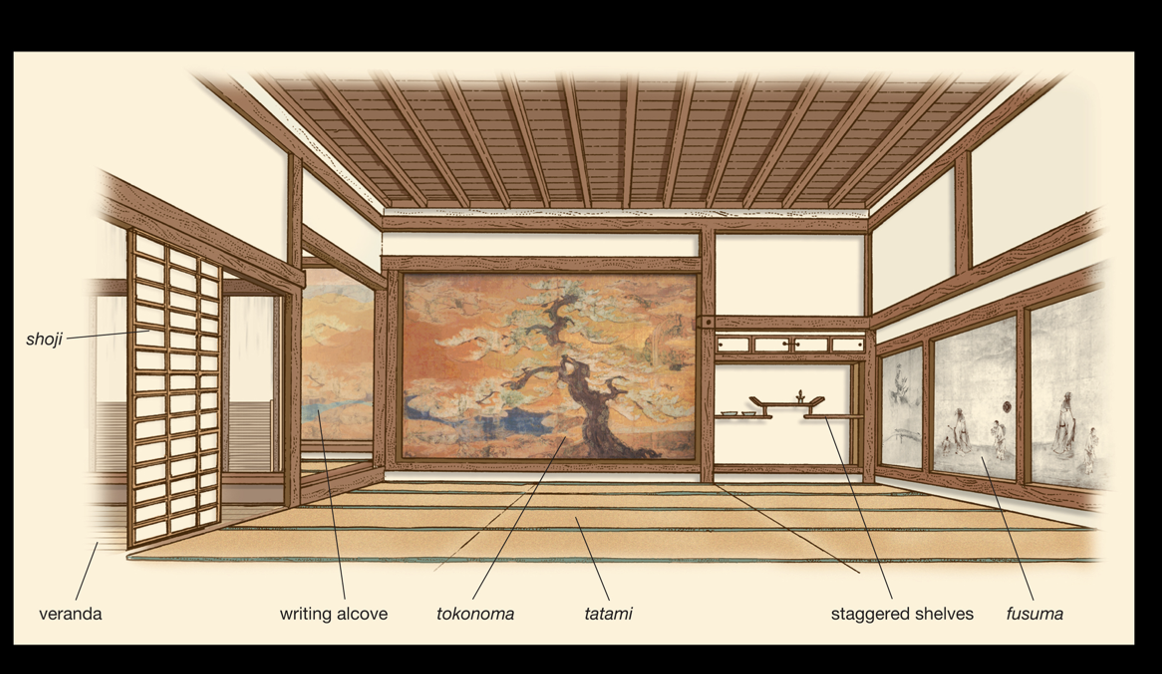
castles like Himeji were decorated giving artist unprecedented opportunities to work on a grand scale.
interior divided into shoin-style rooms by paper covered sliding doors(fusuma). Alcoves were created for specialized placement of art and activities.
Fusuma provided expansive surfaces for large scale murals
Free standing foldings screens(byobu) were also popular
Painting had gold leafed backgrounds with glistening surfaces reflected light back into the rooms demonstrating wealth of warrior leaders who commissioned them. Used in castles, grand reception rooms in temples
artist working in Kano school was called to paint shoin-style rooms
shoin design
Momoyama period
Shoin combined a # of interior features but no 2 rooms are ever the same
Features: wide verandas, walls divided by wooden post, floors covered with woven straw tatami mats, recessed panels in ceilings, Fusuma, shoji screens(wood frames covered with translucent rice paper)
shoin is formal room for upper class guest, rooms were designed for buildings used by samurai, aristocrats, even well to do commoners. Found in various types of buildings:private residence; living quarters, guesthouses, reception rooms at religious complexes; finest house for entertainment where geisha and courtesans entertained important guests.
owner/important guest would sit infront of main alcoves (tokonama), with hanging scrolls, arrangement of flowers, or large painted screens
alongside alvcove are stagered shelves for previous objects
Veranda contained writing space with desk
Architectural harmony of shoin is derived from standardization of its basic units, common module is the bay(distance from the center of one post to center of another, followed with tatami mats. Single tatami about 3×56 ft
shoin room describe by number of tatami mats
Toshusai Sharaku OTANI ONIJI IN THE ROLE OF YAKKO EDOBE
Edo period, 1794. Polychrome woodblock print with ink, colours, and white mica on paper

Japanese woodblock prints
production combines 3 individual specialist:Artist, carver, printer. Coordinating and funding was the publisher job who comissioned the project and distributed the prints to stores or traveling vendors, who would sell them
artist designed and supplied the master drawing for the print, doing its outlines with brush and ink on tissue paper
Colours may be indicated or told afterwards
drawing passed to carver who pasted face down on hardwood block(usually cherry wood), so outline were visible through tissue paper in reversed
Light coat of oil helps make it more transparent allowing drawing to stand out
Then, carver cut around lines of drawing with sharp knife, working is direction of brush work
rest of block chiseled leaving outlines in relief. This block was called master key block which reproduced the master painting.
If print was to be polychrome, prints made from key blocks were pasted face down as carving guides on blocks that would become the coloured blocks.
Each colour diff blocks, but one bloc may have 2 sides
Blocks completed and paper for printing were covered in animal glue(gelatin), and light moistened to tae colour and ink well
water based ink or colour was brushed over blocks , paper placed on top and rubbed with smooth, a padded device called a baren until design was completely transfered
Key block printed first, colour added 1 by 1
each block was carved with 2 small marks called registration marks, in same place in the margins, outside of the image area(l in one corner, straight ine in the other)
Aligning paper with the marks before letting it fall over the block, the printer assured proper colour application within outlines
later japanese prints had grading colour dark top pale, thsi was acheive by wiping colour from the block before printing or by moistening the block and applying the colour gradually with an unenvenly loaded brush(brush loaded on one side with full strenght colour and the other with diluted colour)
What is lacquer
derived from Asia from the sap of the lacquer tree, indeginous to China but also grown commercially throughout East Asia early in history